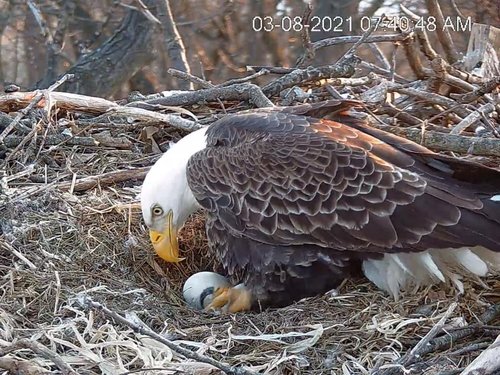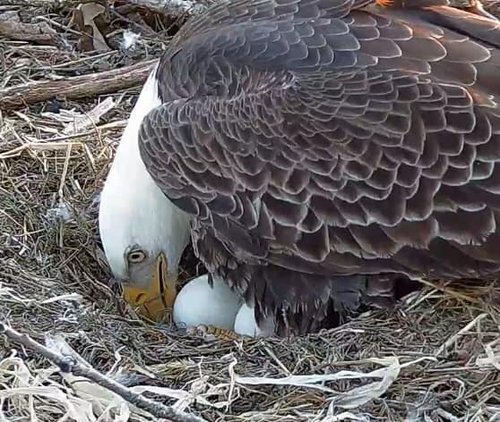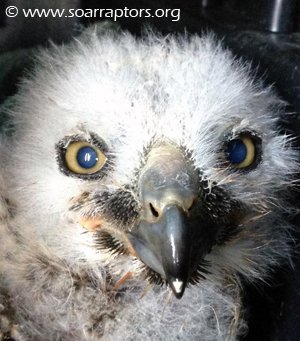Hanover Bald Eagle Blog # 10 - 2021
In partnership with Pennsylvania Game Commission and Comcast Business .

The first Hanover egg was laid 36 days ago, which means hatch day is nearly upon us!
Much of what occurs during the hatching process is hidden from our eyes. During incubation, the egg provides continuous life support for the developing embryo, and naturally the chick must separate from these lifelines before leaving the egg. But how does a tiny youngster achieve such a feat?
Many of us are familiar with the typical cartoon depiction of a hatching bird; an orderly egg-cap pops off and the chick’s adorable wide-eyed head pops out to greet the world. Seemingly nothing to it. The reality of the hatching process, however, is not so simple

When it comes time for the chick to break free of its elliptical home, the blood, oxygen, and food supply must either be transferred to the chick’s body or left behind.
The first transitional step the chick makes to prepare for hatching is to absorb the blood from the network of vessels inside the shell directly into its body.
The second step is for the chick to begin using its own lungs to breathe rather than relying on the oxygen entering through the eggshell pores. Over the course of the incubation period, an air cell forms at the broad end of the egg, and the further along in the incubation stage the larger the air cell becomes. This is because fluids escape through the eggshell as water vapor as the chick develops, leaving room for this air pocket to form. Roughly two days before hatching, the chick punctures this air cell and takes its first self-initiated breath. The eldest Hanover chick has likely already achieved this step.
The third and final important step is for the chick to absorb the remaining yolk contents into its abdomen through a stalk that connects directly to the small intestine. This yolk provides food for the hatchling during the first hours/days of its life.
The timing and details of these pre-hatching steps vary depending on the species, but in general, most birds follow this hatching pattern.
Once the chick has successfully completed the three steps, it’s ready to begin breaking through the shell. To do so, it develops an egg tooth, which is essentially a hard calcium nub at the tip of the bill that allows the chick to knock against the shell and “break through the walls of [its] prison,” as described by William Yarrell, the ornithologist credited with discovering the tooth’s function. Reptiles and egg-laying mammals such as the platypus also have an egg tooth. For most birds, the egg tooth falls off after hatching, however some birds (including finches and sparrows) actually absorb the tooth back into their bill!

Caption: Great-horned owlet with egg tooth still visible
Credit: SOAR, Creative Commons
Eventually, with enough vigorous pecking, called “pipping,” the chick breaks through the eggshell and takes its first breath of fresh air. This infusion of energy allows it to continue hammering away, while simultaneously rotating its body and pressing against the shell. Finally, the chick breaks free.
Interestingly, studies have shown that for many species, the chick begins emitting faint peeps prior to hatching, potentially so the parents know it’s time to orient the egg properly. In the case of the guillemot, a colonial-nesting seabird, this chick-to-parent communication is thought to help the two recognize each other’s vocals, a strategy that could prove helpful once the chick emerges into the colony, where everyone is scrunched together wing-to-wing, and mistaken identity is a real possibility.
After their chick hatches, most parents remove the eggshells from the nest to avoid attracting predators with the bright white of the fragments. Eagles don’t need to worry about this, and often the shells remain in the nest for a short time following hatching.
Merely thinking about the effort required for a chick to hatch is exhausting. Each of the transitional steps are achieved by a baby bird with the biological instinct to ensure its own emergence into the world, and they do this almost entirely on their own, an accomplishment that is simply incredible. Keep your eyes peeled for signs of hatching!

RETURN TO HANOVER BALD EAGLE BLOGS
WATCH THE HANOVER BALD EAGLE LIVE CAMS
For over 20 years, HDOnTap has provided live streaming solutions to resorts, amusement parks, wildlife refuges and more. In addition to maintaining a network of over 400 live webcams, HDOnTap specializes in design and installation of remote, off-grid and otherwise challenging live streaming solutions. Contact press@hdontap.com for all media needs, including images and recordings.